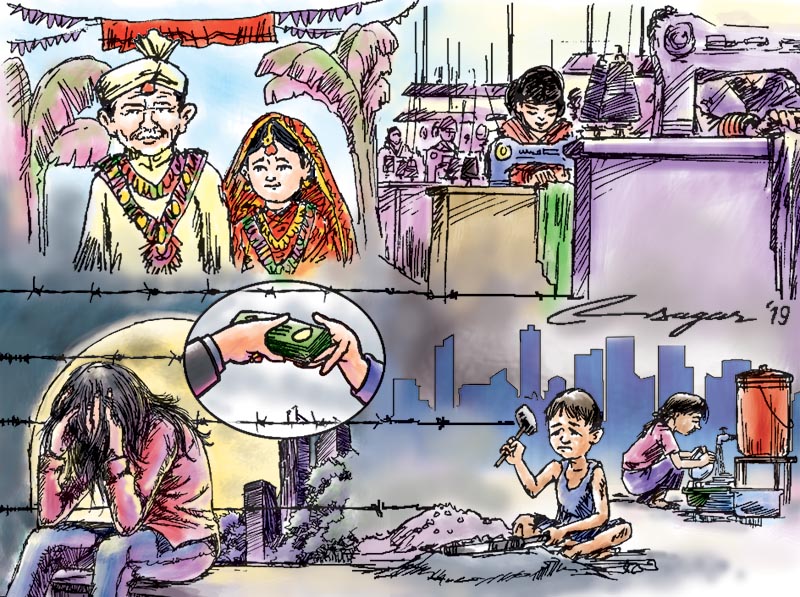Combatting modern slavery: Challenges and opportunities
A recent report of the United Nations Office on Drugs and Crime (UNODC) shows that most of the victims detected across the world are females, mainly adult women, but also increasingly girls
Modern slavery has been thrust on millions of people across the world. An estimated 40.3 million people are enslaved in the world today. Of this, 24.9 million are in forced labour while 4.8 million have been pushed into the flesh trade. Of those enslaved, 10 million are children.
Thus, this situation presents a worrying scenario in terms of both challenges and opportunities for action. Modern slavery has changed its form over the years and continues to harm people in most of the societies. Many young women are still forced into prostitution, men are forced to work in agriculture or construction for low or no pay, and girls are forced into marrying older men. All these have creeping impact on individuals, families and communities at large. Rural poverty, loss of parents and relatives, and destruction of homes and schools have made children and young people even more vulnerable to sexual and labour exploitation in Nepal. Similarly, child labour is also widespread across the country where children are often expected to work from a young age.
Moreover, due to natural disasters, such as earthquakes, children have been forced to look for work further away from their homes, which increases their vulnerability to forced labour and trafficking. And again, young girls who come from the rural areas to the cities for work are at particular risk of sexual exploitation.
Interestingly, many countries are detecting and reporting more victims of trafficking, and are convicting more traffickers. This is due to the increased understanding and capacity of governments and civil
society organisations to identify victims and trafficked victims.
In this context, a recent report of the United Nations Office on Drugs and Crime (UNODC) shows that most of the victims detected across the world are females, mainly adult women, but also increasingly girls. The vast majority of the detected victims of trafficking for sexual exploitation are females, and 35 per cent of the victims trafficked for forced labour are also females, both women and girls. Most of the detected victims are children, both boys and girls, in South Asia. The victims detected were trafficked for sexual exploitation, although this pattern is not consistent across all regions. Trafficking for forced marriage, for example, is more commonly visible in South-East Asia.
The UNODC further reports that the trafficking of children, girls in particular, remains a key concern. Considering the new challenges of trafficking in persons, the UNODC has launched the Global Action to Prevent and Address Trafficking in Persons and the Smuggling of Migrants (GLO.ACT). This has been implemented in partnership with the International Organisation for Migration (IOM) and the United Nations Children’s Fund (UNICEF).
The GLO.ACT intends to provide technical support to the selected countries in developing and implementing comprehensive national counter-trafficking and counter-smuggling responses. These primarily include policy and strategic plan development, capacity building, protection and assistance to victims of trafficking and smuggled migrants, and regional and trans-regional cooperation.
Towards this end, there are a number of regional and international multilateral processes, including SAARC, the Colombo Process, Bali Process, the Inter-Agency Coordination Group against Trafficking in Persons (ICAT), and Alliance 8.7, which seek to collaborate with humanitarian communities to ensure that the risk of trafficking is mitigated from the earliest stages of humanitarian responses.
Some of the existing interventions are largely supporting governments, civil society organisations and the private sector to combat human trafficking.
In addition, there is increasing need of advisory services to private sector entities aimed at eliminating exploitation from their operations and supply chains. This includes actions to promote ethical recruitment of migrant workers – more notably known as International Recruitment Integrity System (IRIS), which is a due diligence tool for businesses, governments and workers.
Because of limited opportunities for decent jobs in the country, many women are migrating to work as domestic workers in the Middle East and other countries. They quite often experience exploitation and abuse. They lack social protection services and hence face the challenges of language, culture and skills in the countries of destination. Modern slavery is deep rooted in our society. There is an emerging need to raise awareness of the risks associated with migration, and develop policies and strategies to mitigate these risks and claim their rights. More importantly, the practical solution lies in educating young girls and teaching them a skill. This can be one of the powerful and effective ways to address the underlying causes of unemployment and poverty.
The government’s efforts alone will not be sufficient to address a range of issues and challenges related to modern slavery. The role of civil society organisations and the private sector is important to protect and promote the rights of victims. More advocacy and networking are needed to influence policy makers for effective implementation of the existing laws and policies to end slavery at large.
Bhandari is a PhD candidate at Chulalongkorn University, Thailand






